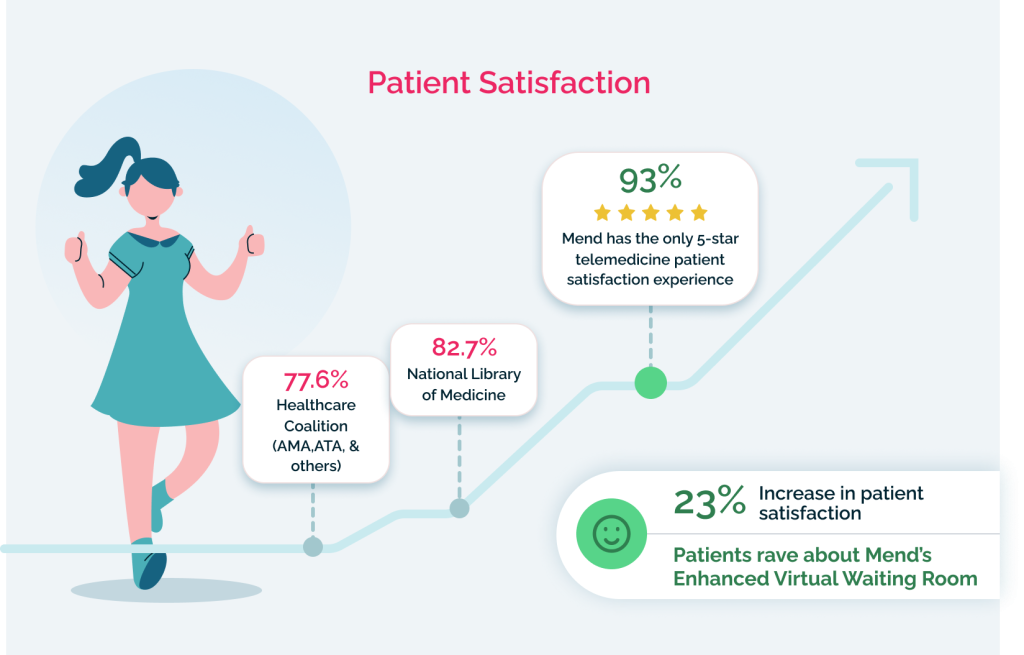6 Telehealth KPIs Every CIO Should Know & Track In 2022

Do you need to maximize the effectiveness of your telehealth program? Here are the top 6 telehealth KPIs every CIO should know & track for success this year.
Are you wondering which telehealth KPIs you should be using to measure the success of your telehealth program? Does your telehealth program check all of the boxes, or was it a temporary fix during the COVID-19 pandemic? These are great questions every CIO or provider should be asking.
Because encounters happen virtually, telehealth programs can offer a wealth of data. Whether you’re considering implementing telehealth or switching from one service to another, it’s essential to know and understand telehealth KPIs. This way, you can leverage the data to benefit your patients and practice.
There are six important indicators to consider with any telehealth program. These include:
- No-show/Drop rates
- Virtual patient wait times
- Patient satisfaction
- Successful encounters
- Connection quality
- Provider Adoption
Let’s further explore each of the telehealth KPIs now.
1. No-Show/Drop Rates
The number one reason providers implement telehealth in their practice is to increase productivity. This occurs by decreasing the rate of no-shows or last-minute cancellations. The average no-show rate across the globe is 23%. For the average 10-provider practice, that’s an annual loss of $857,808.
The ability to track this key performance indicators for telehealth over time can increase patient attendance rates and help unprofitable organizations become profitable.
Mend can also help predict which patients are at high risk for a no-show or cancellation. The artificially intelligent (AI) algorithm first predicts when a patient may not show. Then, the system automatically sends an appointment reminder sequence that encourages them to confirm or reschedule. When you enable Mend telehealth in your practice, the no-show rate is in the single digits.
- Average no show rate is 23%
- Annual loss of $857,808 for 10-provider practice
- With Mend’s telehealth enabled, no-show rate reduces to single digits
2. Virtual Patient Wait Times
Another important telehealth KPI to assess is the virtual patient wait time. By connecting virtually, patients already save time on commutes, which is a plus for telehealth. Yet long wait times can hurt patient satisfaction, whether in-person or virtual.
That’s why it’s important to keep the wait time as low as possible. Automated patient intake forms via telehealth platform integration can help this process. With Mend, you can use templated intake forms. Or, you can custom design your own to replicate any workflow. Forms can then be sent manually or automatically to patients triggered by appointment types. This technology will allow the patient to complete the form ahead of the appointment or contact their providers’ office with questions. Completing the forms ahead of the appointment in a secure HIPAA compliant format significantly decreases the wait time prior to connecting with a physician.
3. Patient Satisfaction
Patient satisfaction is one of the most important telehealth KPIs for measuring the success of any program. Yet some lists of telehealth KPIs often overlook this element. If a patient doesn’t have a satisfactory experience, they are less likely to return to that provider.
With increasing demands on providers, periods of waiting are unavoidable entirely. This leaves the question of how telehealth programs can help make the most of this time. Some telehealth platforms, like Mend, offer content while the patient is waiting. However, Mend is the only telehealth platform to offer a robust, enhanced waiting room experience. Designed with a Netflix-like interface, patients can choose video content to engage with while they wait. This may include informational videos or custom content about a provider or organization.
- 15-20 minutes, average virtual patient wait time across the US
- 13:35 minutes, average wait time with Mend
Some vital benchmarks for patient satisfaction include ease of use, low waiting times and instant technical support. The provider’s ability to provide information clearly over the virtual platform is also an important consideration. When implementing any telehealth program, closely monitoring this KPI will indicate the success of the overall clinical delivery. Patient demos can also help get patients on board for virtual care and improve success rates.
- 93% satisfaction rate with Mend, with the only 5-star telemedicine patient satisfaction experience
- 23% increase in patient satisfaction after enabling Mend’s Enhanced Virtual Waiting Room experience
- 23 seconds average response time for technical support for patients as well as staff

4. Successful Encounters
Of the six telehealth KPIs, successful encounters are the most challenging metric to measure success of telemedicine program. That’s because it can be difficult for some telehealth platforms to analyze if a visit was accurately coded and then submitted for billing.
To solve this, Mend uses an integration to help aggregate data within a provider office or across an organization. Mend integrates with 81 EHRs to pull pertinent data. This may include if a provider has been connected for at least 2 minutes for a virtual appointment or if the appointment was marked as checked out. If one or both of these elements occur, there is a high probability of a successful encounter.
- 94% of visits are successful on Mend
Schedule A Call Today with Mend
5. Connection Quality
The number one concern for any telehealth program is connectivity. If providers can’t connect with their patients, delivering virtual care can be challenging or impossible. Closely examining this telehealth KPI on both the patient and provider sides can help improve overall outcomes.
With some platforms, it’s possible to assess which patients may have a poor internet connection. Mend, for example, will help develop processes to connect these patients when connectivity issues are identified ahead of the scheduled appointment. In other instances, telehealth kiosks can be made available.
On the provider side, poor upload speed can affect the telehealth quality metrics of all the virtual visits. Mend can work together with an organization’s IT department to identify any staff member averaging under 100 Kbps. User and appointment average bitrate reports are also available for monitoring and assessing ongoing connection quality.
- Mend works on 3G networks, with backup audio call
- 98% of patients have strong internet quality from proactive organizations that follow best practices
- 92% of patients have good internet quality on average across Mend
6. Provider Adoption
As with any software investment, you want to ensure that the application is utilized. Provider adoption is the final of the six telehealth KPIs to consider when implementing a telehealth program.
Many platforms can easily track this telehealth performance metric. Yet the rate of adoption will vary from organization to organization and provider to provider. For example, behavioral health physicians may implement telehealth services in their day-to-day practice. Physical therapists, on the other hand, may occasionally utilize the service.
Organizations may also choose to purchase an Enterprise software license with a platform like Mend. In this case, any provider can access it whenever they need it. When this happens, Mend telemedicine performance metrics will also measure the success of provider adoption when the software goes live.
- 98% provider retention after ~20 telehealth visits across Mend
Find the best telehealth solution for your practice today.
While digital options were already increasing, the COVID-19 pandemic was a catalyst for the implementation of telehealth. In fact, 97% of primary care providers turned to virtual practices over the course of 2020. This was a crucial step in the continuity of patient care.
If you implemented telehealth software in your organization during the pandemic, you might now be wondering if it does everything you need it to do. Measuring telehealth KPIs is one way to gauge the success of a program.
At Mend, we’ve helped over 4,600,000 patients and growing, so we know how to help you connect with your patients from virtually anywhere. We work closely with our clients to monitor telehealth KPIs to ensure the success and effectiveness of our program. To explore everything Mend has to offer, schedule a demo today with our experts to learn more.